Samsung SM-T585 User Manual

USER MANUAL
SM-T585
English (EU). 12/2018. Rev.1.0 |
www.samsung.com |
Table of Contents
Basics
4 Read me first
6Device overheating situations and solutions
9 Device layout and functions
13 Battery
15SIM or USIM card (nano-SIM card)
16Memory card (microSD card)
19Turning the device on and off
20Initial setup
22 Samsung account
24Transferring data from your previous device
28 Understanding the screen
38 Notification panel
40 Entering text
Apps and features
42 Installing or uninstalling apps
44 Phone
49 Contacts
53 Messages
55 Internet
57Email
58Camera
66Gallery
73Multi window
77Memo
78Calendar
79My Files
80Clock
82Calculator
83SmartThings
87Sharing content
88Kids Mode
89Google apps
2

Table of Contents
Settings |
Appendix |
|||
91 |
Introduction |
123 |
Troubleshooting |
|
91 |
Connections |
129 |
Removing the battery |
|
|
92 |
Wi-Fi |
|
|
|
94 |
Bluetooth |
|
|
|
96 |
Data saver |
|
|
96Mobile Hotspot and Tethering
97More connection settings 100 Sounds and vibration
101 Notifications
101 Display
102Screensaver 102 Wallpaper
103 Advanced features
104 Device maintenance
106 Apps
107 Lock screen
107Smart Lock 108 Security
109Private mode
111Secure Folder 116 Cloud and accounts
117Users 118 Google 119 Accessibility
120 General management
121 Software update
122 User manual
122 About tablet
3
Basics
Read me first
Please read this manual before using the device to ensure safe and proper use.
•Descriptions are based on the device’s default settings.
•Some content may differ from your device depending on the region, service provider, model specifications, or device’s software.
•Content (high quality content) that requires high CPU and RAM usage will affect the overall performance of the device. Apps related to the content may not work properly depending on the device’s specifications and the environment that it is used in.
•Samsung is not liable for performance issues caused by apps supplied by providers other than Samsung.
•Samsung is not liable for performance issues or incompatibilities caused by edited registry settings or modified operating system software. Attempting to customise the operating system may cause the device or apps to work improperly.
•Software, sound sources, wallpapers, images, and other media provided with this device are licensed for limited use. Extracting and using these materials for commercial or other purposes is an infringement of copyright laws. Users are entirely responsible for illegal use of media.
•You may incur additional charges for data services, such as messaging, uploading and downloading, auto-syncing, or using location services depending on your data plan. For large data transfers, it is recommended to use the Wi-Fi feature.
•Default apps that come with the device are subject to updates and may no longer be supported without prior notice. If you have questions about an app provided with the device, contact a Samsung Service Centre. For user-installed apps, contact service providers.
4

Basics
•Modifying the device’s operating system or installing softwares from unofficial sources may result in device malfunctions and data corruption or loss. These actions are violations of your Samsung licence agreement and will void your warranty.
•Depending on the region or model, some devices are required to receive approval from the Federal Communications Commission (FCC). If your device is approved by the FCC, you can view the FCC ID of the device. To view the FCC ID, launch the Settings app and tap About tablet →Status.
•Depending on the region, you can view the regulatory information on the device. To view the information, launch the Settings app and tap About tablet →Regulatory information.
Instructional icons
Warning: situations that could cause injury to yourself or others
Caution: situations that could cause damage to your device or other equipment
Notice: notes, usage tips, or additional information
5

Basics
Device overheating situations and solutions
When the device heats up while charging the battery
While charging, the device and the charger may become hot. During wireless charging or fast charging, the device may feel hotter to the touch. This does not affect the device’s lifespan or performance and is in the device’s normal range of operation. If the battery becomes too hot, the charger may stop charging.
Do the following when the device heats up:
•Disconnect the charger from the device and close any running apps. Wait for the device to cool down and then begin charging the device again.
•If the lower part of the device overheats, it could be because the connected USB cable is damaged. Replace the damaged USB cable with a new Samsung-approved one.
•When using a wireless charger, do not place foreign materials, such as metal objects, magnets, and magnetic stripe cards, between the device and the wireless charger.
The wireless charging or fast charging feature is only available on supported models.
When the device heats up during use
When you use features or apps that require more power or use them for extended periods, your device may temporarily heat up due to increased battery consumption. Close any running apps and do not use the device for a while.
The following are examples of situations in which the device may overheat. Depending on the functions and apps you use, these examples may not apply to your model.
•During the initial setup after purchase or when restoring data
•When downloading large files
6

Basics
•When using apps that require more power or using apps for extended periods
––When playing high-quality games for extended periods
––When recording videos for extended periods
––When streaming videos while using the maximum brightness setting
––When connecting to a TV
•While multitasking (or, when running many apps in the background)
––When using Multi window
––When updating or installing apps while recording videos
––When downloading large files during a video call
––When recording videos while using a navigation app
•When using large amount of data for syncing with the cloud, email, or other accounts
•When using a navigation app in a car while the device is placed in direct sunlight
•When using the mobile hotspot and tethering feature
•When using the device in areas with weak signals or no reception
•When charging the battery with a damaged USB cable
•When the device’s multipurpose jack is damaged or exposed to foreign materials, such as liquid, dust, metal powder, and pencil lead
•When you are roaming
Do the following when the device heats up:
•Keep the device updated with the latest software.
•Conflicts between running apps may cause the device to heat up. Restart the device.
•Deactivate the Wi-Fi, GPS, and Bluetooth features when not using them.
•Close apps that increase battery consumption or that run in the background when not in use.
•Delete unnecessary files or unused apps.
•Decrease the screen brightness.
•If the device overheats or feels hot for a prolonged period, do not use it for a while. If the device continues to overheat, contact a Samsung Service Centre.
7

Basics
Device limitations when the device overheats
When the device heats up, the features and performance may be limited or the device may turn off to cool down. The feature is only available on supported models.
•If the device becomes hotter than usual, a device overheating message will appear. To lower the device’s temperature, the screen brightness and the performance speed will be limited and battery charging will stop. Running apps will be closed and you will only be able to make emergency calls until the device cools down.
•If the device overheats or feels hot for a prolonged period, a power off message will appear. Turn off the device, and wait until it cools down.
Precautions for operating environment
Your device may heat up due to the environment in the following conditions. Use caution to avoid shortening the battery’s lifespan, damaging the device, or causing a fire.
•Do not store your device in very cold or very hot temperatures.
•Do not expose your device to direct sunlight for extended periods.
•Do not use or store your device for extended periods in very hot areas, such as inside a car in the summertime.
•Do not place the device in any areas that may overheat, such as on an electric heating mat.
•Do not store your device near or in heaters, microwaves, hot cooking equipment, or high pressure containers.
•Never use a damaged charger or battery.
8

Basics
Device layout and functions
Package contents
Check the product box for the following items:
•Device
•Quick start guide
•The items supplied with the device and any available accessories may vary depending on the region or service provider.
•The supplied items are designed only for this device and may not be compatible with other devices.
•Appearances and specifications are subject to change without prior notice.
•You can purchase additional accessories from your local Samsung retailer. Make sure they are compatible with the device before purchase.
•Use only Samsung-approved accessories. Using unapproved accessories may cause the performance problems and malfunctions that are not covered by the warranty.
•Availability of all accessories is subject to change depending entirely on manufacturing companies. For more information about available accessories, refer to the Samsung website.
9
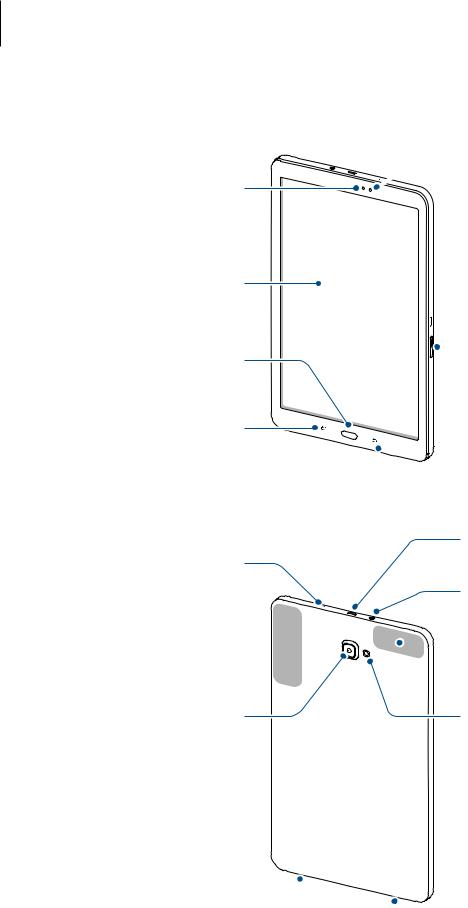
Basics
Device layout
Light sensor
Touchscreen
Home key
Recents key
Microphone
GPS antenna 
Rear camera
Loud speaker
 Front camera
Front camera

 Power key
Power key

 Volume key
Volume key

 Memory card slot
Memory card slot
 SIM card slot
SIM card slot
 Back key
Back key
Multipurpose jack
 Headset jack
Headset jack
 Main antenna Flash
Main antenna Flash
 Loud speaker
Loud speaker
10

Basics
The device and some accessories (sold separately) contain magnets. The American Heart Association (US) and the Medicines and Healthcare Products Regulatory Agency (UK) both warn that magnets can affect the operation of implanted pacemakers, cardioverters, defibrillators, insulin pumps or other electro medical devices (collectively,“Medical Device”) within the range of 15 cm (6 inches). If you are a user of any of these Medical Devices, DO NOT USE THIS DEVICE AND SOME ACCESSORIES (SOLD SEPARATELY) UNLESS YOU HAVE CONSULTED WITH YOUR PHYSICIAN.
• Be careful not to expose the camera lens to a strong light source, such as direct sunlight. If the camera lens is exposed to a strong light source, such as direct sunlight, the camera image sensor may be damaged. A damaged image sensor is irreparable and will cause dots or spots in pictures.
•Do not store your device and some accessories (sold separately) near magnetic fields. Magnetic stripe cards, including credit cards, phone cards, passbooks, and boarding passes, may be damaged by magnetic fields.
•Connectivity problems and battery drain may occur in the following situations:
––If you attach metallic stickers on the antenna area of the device
––If you attach a device cover made with metallic material to the device
––If you cover the device’s antenna area with your hands or other objects while using certain features, such as calls or the mobile data connection
•Using a Samsung-approved screen protector is recommended. Unapproved screen protectors may cause the sensors to malfunction.
•Do not allow water to contact the touchscreen. The touchscreen may malfunction in humid conditions or when exposed to water.
11

Basics
Keys
Key |
Function |
|||
|
|
Power |
• |
Press and hold to turn the device on or off. |
|
|
• |
Press to turn on or lock the screen. |
|
|
|
|
||
|
|
|
|
|
|
|
Recents |
• |
Tap to open the list of recent apps. |
|
|
|||
|
|
|
|
|
|
|
|
• |
Press to turn on the screen while the screen is locked. |
|
|
Home |
• |
Press to return to the Home screen. |
|
|
|
• |
Press and hold to launch Google. |
|
|
|
|
|
|
|
|
• |
Tap to return to the previous screen. |
|
|
Back |
• |
Tap and hold to access additional options for the current |
|
|
|||
|
|
|
|
screen. |
|
|
|
|
|
|
|
Volume |
• |
Press to adjust the device volume. |
|
|
|
|
|
12
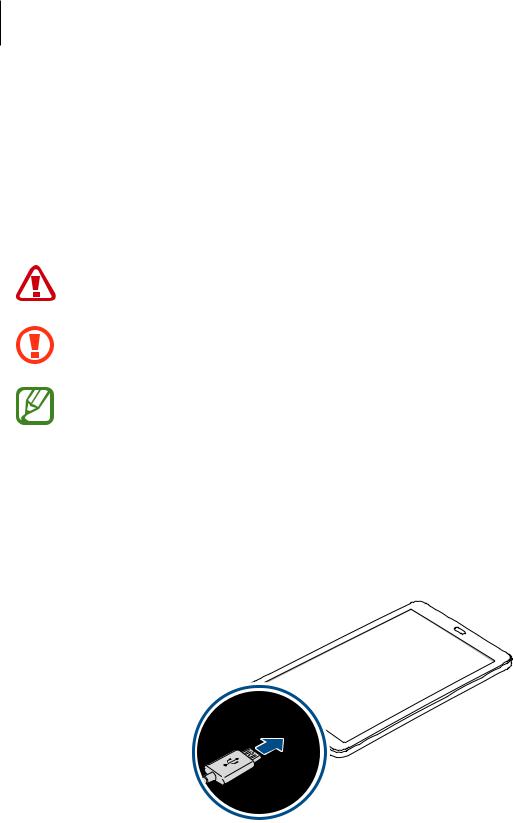
Basics
Battery
Charging the battery
Charge the battery before using it for the first time or when it has been unused for extended periods.
1
2
Use only Samsung-approved chargers, batteries, and cables. Unapproved chargers or cables can cause the battery to explode or damage the device.
Connecting the charger improperly may cause serious damage to the device. Any damage caused by misuse is not covered by the warranty.
To save energy, unplug the charger when not in use. The charger does not have a power switch, so you must unplug the charger from the electric socket when not in use to avoid wasting power. The charger should remain close to the electric socket and easily accessible while charging.
Connect the USB cable to the USB power adaptor.
Plug the USB cable into the device’s multipurpose jack.
3
4
Plug the USB power adaptor into an electric socket.
After fully charging, disconnect the charger from the device. Then, unplug the charger from the electric socket.
13

Basics
Reducing the battery consumption
Your device provides various options that help you conserve battery power.
•Optimise the device using the device maintenance feature.
•When you are not using the device, turn off the screen by pressing the Power key.
•Activate power saving mode.
•Close unnecessary apps.
•Deactivate the Bluetooth feature when not in use.
•Deactivate the Wi-Fi feature when not in use.
•Deactivate auto-syncing of apps that need to be synced.
•Decrease the backlight time.
•Decrease the screen brightness.
Battery charging tips and precautions
•When the battery power is low, the battery icon appears empty.
•If the battery is completely discharged, the device cannot be turned on immediately when the charger is connected. Allow a depleted battery to charge for a few minutes before turning on the device.
•If you use multiple apps at once, network apps, or apps that need a connection to another device, the battery will drain quickly. To avoid losing power during a data transfer, always use these apps after fully charging the battery.
•Using a power source other than the charger, such as a computer, may result in a slower charging speed due to a lower electric current.
•The device can be used while it is charging, but it may take longer to fully charge the battery.
•If the device receives an unstable power supply while charging, the touchscreen may not function. If this happens, unplug the charger from the device.
•While charging, the device and the charger may heat up. This is normal and should not affect the device’s lifespan or performance. If the battery gets hotter than usual, the charger may stop charging.
•If you charge the device while the multipurpose jack is wet, the device may be damaged. Thoroughly dry the multipurpose jack before charging the device.
•If the device is not charging properly, take the device and the charger to a Samsung Service Centre.
14
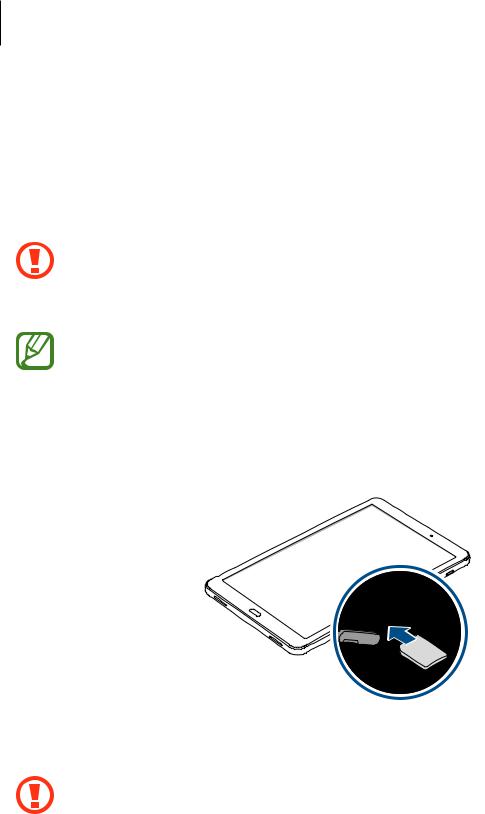
Basics
SIM or USIM card (nano-SIM card)
Installing the SIM or USIM card
Insert the SIM or USIM card provided by the mobile telephone service provider.
1
2
•Use only a nano-SIM card.
•Use caution not to lose or let others use the SIM or USIM card. Samsung is not responsible for any damages or inconveniences caused by lost or stolen cards.
Some LTE services may not be available depending on the service provider. For more information about service availability, contact your service provider.
Open the cover of the SIM card slot.
Insert the SIM or USIM card with the gold-coloured contacts facing downwards.
3 Push the SIM or USIM card into the slot until it locks in place.
Do not insert a memory card into the SIM card slot. If a memory card happens to be lodged in the SIM card slot, take the device to a Samsung Service Centre to remove the memory card.
4 Close the cover of the SIM card slot.
15
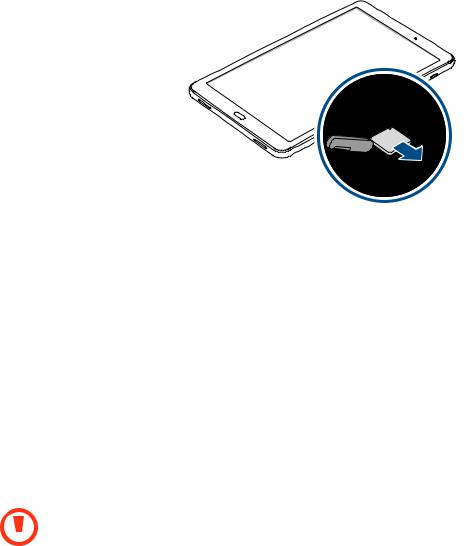
Basics
Removing the SIM or USIM card
1
2
Open the cover of the SIM card slot.
Press the SIM or USIM card with your finger, and then pull it out.
3 Close the cover of the SIM card slot.
Memory card (microSD card)
Installing a memory card
Your device’s memory card capacity may vary from other models and some memory cards may not be compatible with your device depending on the memory card manufacturer and type. To view your device’s maximum memory card capacity, refer to the Samsung website.
|
• |
Some memory cards may not be fully compatible with the device. Using an |
|
|
incompatible card may damage the device or the memory card, or corrupt the data |
|
|
|
|
|
|
|
|
stored in it. |
|
• |
Use caution to insert the memory card right-side up. |
16
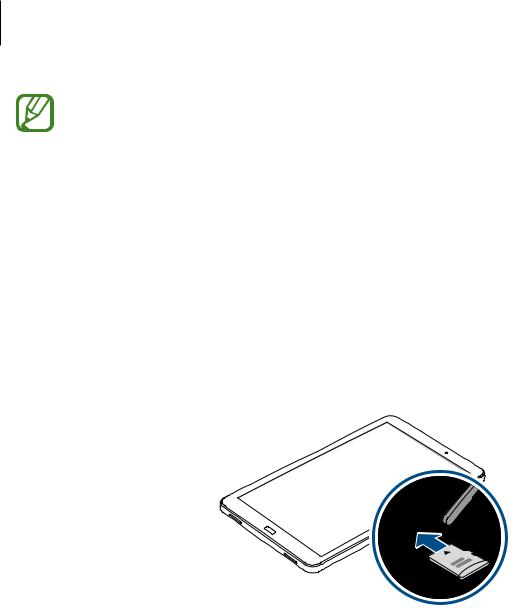
Basics
1
2
•The device supports the FAT and the exFAT file systems for memory cards. When inserting a card formatted in a different file system, the device will ask to reformat the card or will not recognise the card. To use the memory card, you must format it. If your device cannot format or recognise the memory card, contact the memory card manufacturer or a Samsung Service Centre.
•Frequent writing and erasing of data shortens the lifespan of memory cards.
•When inserting a memory card into the device, the memory card’s file directory appears in the My Files →SD card folder.
Open the cover of the memory card slot.
Insert a memory card with the gold-coloured contacts facing downwards.
3
4
Push the memory card into the slot until it locks in place. Close the cover of the memory card slot.
17

Basics
Removing the memory card
Before removing the memory card, first unmount it for safe removal.
Launch the Settings app and tap Device maintenance →Storage → →Storage settings →SD card →UNMOUNT.
→Storage settings →SD card →UNMOUNT.
1
2
3
Open the cover of the memory card slot.
Push the memory card until it disengages from the device, and then pull it out.
Close the cover of the memory card slot.
Do not remove external storage, such as a memory card or USB storage, while the device is transferring or accessing information, or right after transferring data. Doing so can cause data to be corrupted or lost or cause damage to the external storage or device. Samsung is not responsible for losses, including loss of data, resulting from the misuse of external storage devices.
Formatting the memory card
A memory card formatted on a computer may not be compatible with the device. Format the memory card on the device.
Launch the Settings app and tap Device maintenance →Storage → →Storage settings →SD card →Format.
→Storage settings →SD card →Format.
Before formatting the memory card, remember to make backup copies of all important data stored in the memory card. The manufacturer’s warranty does not cover loss of data resulting from user actions.
18

Basics
Turning the device on and off
Press and hold the Power key for a few seconds to turn on the device.
When you turn on your device for the first time or after performing a data reset, follow the onscreen instructions to set up your device.
To turn off the device, press and hold the Power key, and then tap Power off.
Follow all posted warnings and directions from authorised personnel in areas where the use of wireless devices is restricted, such as aeroplanes and hospitals.
Restarting the device
If your device is frozen and unresponsive, press and hold the Power key and the Volume Down key simultaneously for more than 7 seconds to restart it.
Power key
Volume Down key
19
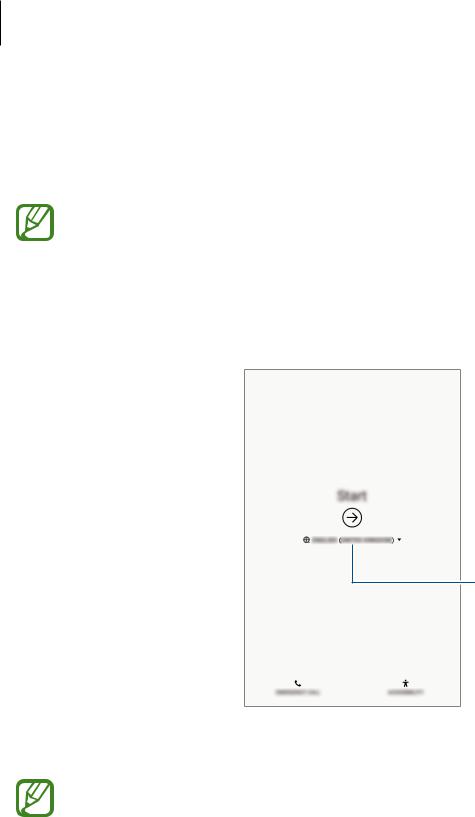
Basics
Initial setup
When you turn on your device for the first time or after performing a data reset, follow the onscreen instructions to set up your device.
The initial setup procedures may vary depending on the device’s software and your region.
1
2
Turn on the device.
Select your preferred device language and select  .
.
Select a language.
3 Select a Wi-Fi network and connect to it.
If you do not connect to a Wi-Fi network, you may not be able to set up some device features during the initial setup.
4
5
Follow the on-screen instructions to proceed the initial setup.
Set a screen lock method to protect your device. You can protect your personal information by preventing others from accessing your device. To set the screen lock method later, tap Not now.
20
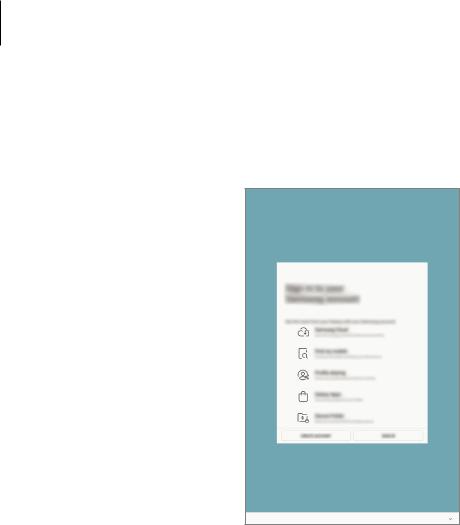
Basics
6 Sign in to your Samsung account. You can enjoy Samsung services and keep your data up to date and secure across all of your devices. Refer to Samsung account for more information.
7 Select features you want to use and complete the initial setup. The Home screen will appear.
21

Basics
Samsung account
Introduction
Your Samsung account is an integrated account service that allows you to use a variety of Samsung services provided by mobile devices, TVs, and the Samsung website. Once your Samsung account has been registered, you can keep your data up to date and secure across your Samsung devices with Samsung Cloud, track and control your lost or stolen device, and more.
Create your Samsung account with your email address.
To check the list of services that can be used with your Samsung account, visit account.samsung.com. For more information on Samsung accounts, launch the Settings app and tap Cloud and accounts →Accounts →Samsung account → →Help.
→Help.
Registering your Samsung account
Registering a new Samsung account
If you do not have a Samsung account, you should create one.
1
2
3
Launch the Settings app and tap Cloud and accounts →Accounts →Add account. Tap Samsung account →CREATE ACCOUNT.
Follow the on-screen instructions to complete creating your account.
22

Basics
Registering an existing Samsung account
If you already have a Samsung account, register it to the device.
1
2
3
Launch the Settings app and tap Cloud and accounts →Accounts →Add account. Tap Samsung account →SIGN IN.
Enter your email address and password, and then tap SIGN IN.
If you forget your account information, tap Find ID or Reset password. You can find your account information when you enter the required information.
4
5 Tap DONE to finish registering your Samsung account.
Removing your Samsung account
When you remove your registered Samsung account from the device, your data, such as contacts or events, will also be removed.
1 |
Launch the Settings app and tap Cloud and accounts →Accounts. |
2 |
Tap Samsung account → →Remove account. |
3 |
Tap REMOVE, enter your Samsung account password, and then tap CONFIRM. |
23
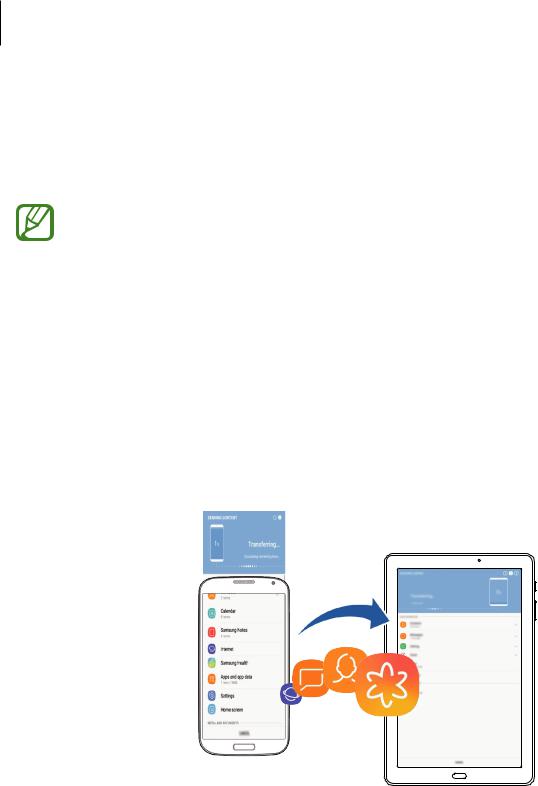
Basics
Transferring data from your previous device
You can restore your data, such as images, contacts, messages, and apps from Samsung Cloud. You can also copy them from your previous device via Smart Switch.
•This feature may not be supported on some devices or computers.
•Limitations apply. Visit www.samsung.com/smartswitch for details. Samsung takes copyright seriously. Only transfer content that you own or have the right to transfer.
Smart Switch
Transfer data between mobile devices via Smart Switch. To use Smart Switch, launch the
Settings app and tap Cloud and accounts →Smart Switch. If you do not have the app, download it from Galaxy Apps or Play Store.
Transferring data from a mobile device
Transfer data from your previous device to your device wirelessly via Wi-Fi Direct.
24

Basics
1
2
3
4
5
6
On the previous device, launch Smart Switch.
If you do not have the app, download it from Galaxy Apps or Play Store.
On your device, launch the Settings app and tap Cloud and accounts →Smart Switch. Place the devices near each other.
On the previous device, tap WIRELESS →SEND.
On your device, tap WIRELESS →RECEIVE and select the previous device type. Follow the on-screen instructions to transfer data from your previous device.
Transferring data using external storage
Transfer data using external storage, such as a microSD card.
1 |
Transfer data from your previous device to external storage. |
2 |
Insert or connect the external storage device to your device. |
3 |
On your device, launch the Settings app and tap Cloud and accounts →Smart Switch |
|
→EXTERNAL STORAGE →RESTORE. |
4 |
Follow the on-screen instructions to transfer data from external storage. |
25
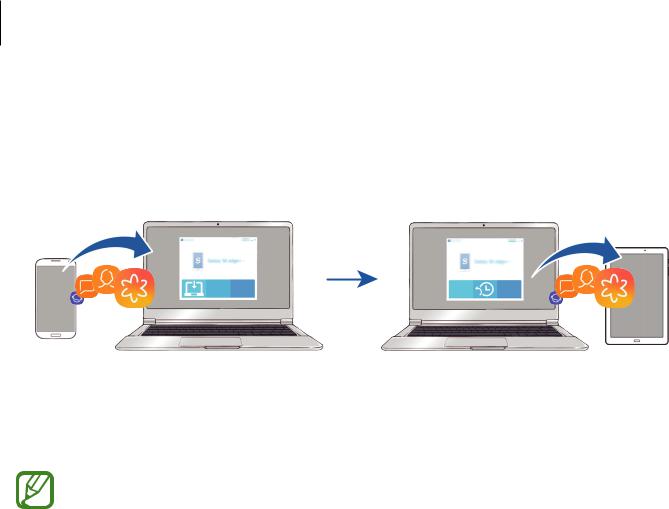
Basics
Transferring backup data from a computer
Transfer data between your device and a computer. You must download the Smart Switch computer version app from www.samsung.com/smartswitch. Back up data from your previous device to a computer and import the data to your device.
1
2
On the computer, visit www.samsung.com/smartswitch to download Smart Switch.
On the computer, launch Smart Switch.
If your previous device is not a Samsung device, back up data to a computer using a program provided by the device’s manufacturer. Then, skip to the fifth step.
3
4
Connect your previous device to the computer using the device’s USB cable.
On the computer, follow the on-screen instructions to back up data from the device. Then, disconnect your previous device from the computer.
5
6
Connect your device to the computer using the USB cable.
On the computer, follow the on-screen instructions to transfer data to your device.
Viewing imported data
You can view the imported data on the same app from your previous device.
If your new device does not have the same apps to view or play the imported data, the data will be saved to a similar app. For example, if you import notes and your device does not have the Samsung Notes app, you can view the memos in the Memo app.
26

Basics
Samsung Cloud
Back up data from your previous device to Samsung Cloud and restore the data to your new device. You must register and sign in to your Samsung account to use Samsung Cloud. Refer to Samsung account for more information.
Backing up data
1
2
On your previous device, sign in to your Samsung account.
Launch the Settings app, select the backup option, and back up your data.
•If your device supports Samsung Cloud, launch the Settings app, tap Cloud and accounts →Samsung Cloud, select your device under BACKUP AND RESTORE, tap Back up, and then back up your data.
•The data backup method may vary depending on your model.
•Some data will not be backed up. To check which data will be backed up, launch the Settings app, tap Cloud and accounts →Samsung Cloud, select your device under BACKUP AND RESTORE, and then tap Back up.
Restoring data
1
2
3
On your new device, launch the Settings app and tap Cloud and accounts →Samsung Cloud.
Select your previous device under BACKUP AND RESTORE and tap Restore data.
Tick the data types you want to restore and tap RESTORE.
27

Basics
Syncing data
You can sync data saved in your device with Samsung Cloud and access it from other devices.
1
2
3
On your new device, launch the Settings app and tap Cloud and accounts →Samsung Cloud.
Tap  →Settings →Sync settings.
→Settings →Sync settings.
Tap the switches next to the items you want to sync with.
Checking data
You can check the saved items and used memory of your Samsung Cloud. Launch the
Settings app and tap Cloud and accounts →Samsung Cloud.
•You can immediately check your used memory and saved items, such as, GALLERY and SAMSUNG CLOUD DRIVE. Tap each card and enter the next page. You can change the settings or check the saved data.
•You can check the backup data in your Samsung account by using the BACKUP AND RESTORE option. Select your device and tap Restore data.
Understanding the screen
Controlling the touchscreen
• Do not allow the touchscreen to come into contact with other electrical devices. Electrostatic discharges can cause the touchscreen to malfunction.
•To avoid damaging the touchscreen, do not tap it with anything sharp or apply excessive pressure to it with your fingertips.
•Leaving the touchscreen idle for extended periods may result in afterimages (screen burn-in) or ghosting. Turn off the touchscreen when you do not use the device.
•The device may not recognise touch inputs close to the edges of the screen, which are outside of the touch input area.
•It is recommended to use fingers when you use the touchscreen.
28

Basics
Tapping
Tap the screen.
Tapping and holding
Tap and hold the screen for approximately 2 seconds.
Dragging
Tap and hold an item and drag it to the target position.
29

Basics
Double-tapping
Double-tap the screen.
Swiping
Swipe upwards, downwards, to the left, or to the right.
Spreading and pinching
Spread two fingers apart or pinch on the screen.
30
